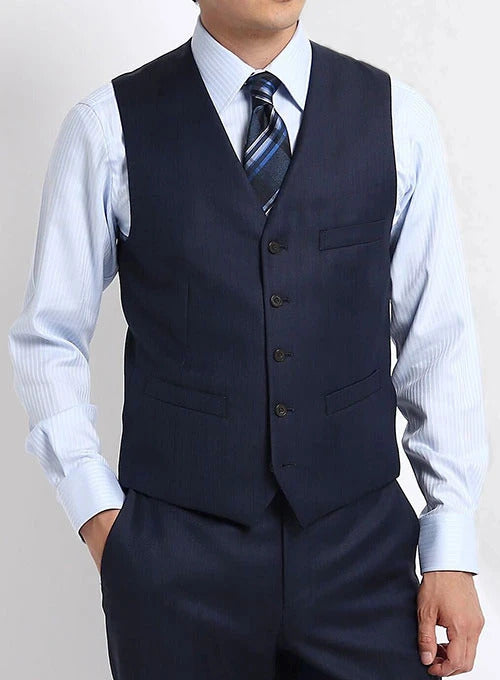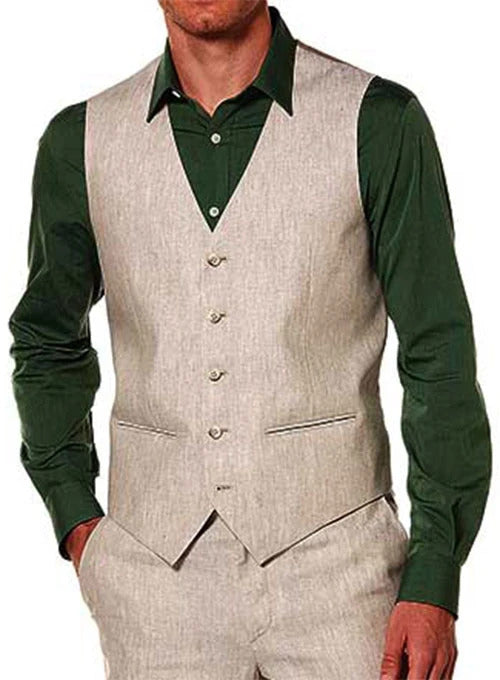A waistcoat is an essential part of a three-piece suit. While two-piece suits only consist of a jacket and matching trousers, three-piece suits include a waistcoat. Also known simply as a vest, a waistcoat is a sleeveless upper-body garment that's included in a three-piece suit. If you're planning to wear a waistcoat, though, you should follow these dos and don'ts to achieve a picture-perfect suit outfit.
Do Match With Trousers
For most suit outfits, you should wear a waistcoat that matches the trousers. The color of your waistcoat should match that of your trousers. If your suit trousers are beige, you should choose a beige waistcoat. If your suit trousers are black, on the other hand, you should choose a black waistcoat. Ensuring that your waistcoat matches your trousers will help you create a more cohesive suit outfit.
Don't Mix Fabrics
Avoid mixing fabrics when wearing a waistcoat. Three-piece suits, of course, consist of a suit jacket, trousers and waistcoat. All of these garments should be made of the same type of fabric. Mixing fabrics will only result in an eclectic appearance that's not particularly stylish. You can find suits in cotton, linen, wool and other fabrics. Regardless, make sure your waistcoat is made of the same type of fabric as your suit jacket and trousers.
All three garments in a three-piece should be made of the same fabric. Your suit jacket, trousers and waistcoat shouldn't be made of different fabrics. For a more uniform appearance, stick with a single fabric. Mixing fabrics is a common mistake men make when wearing three-piece suits. By sticking with a single fabric, you can avoid this fashion faux pas.
Do Choose a Form-Fitting Waistcoat
You should choose a form-fitting waistcoat. What is a form-fitting waistcoat? The term "form-fitting" refers to a snug fit in which a given garment sits close against your body when worn. Some waistcoats are baggy. Rather than sitting close against your body when worn, they essentially drape or hang from your body. Form-fitting waistcoats are always a better choice because they provide a cleaner and more uniform appearance.
With a form-fitting waistcoat, you'll reap the following benefits
- Slimmer and taller appearance
- Easier to maintain
- Complements your suit
- Better protected from wrinkles
- Offers increased warmth during the winter
- Formal style that's synonymous with suits
Don't Expose to Excessive Heat
Avoid exposing your waistcoat to excessive heat. Whether it's from a clothing iron, the washing machine or a dryer, heat can damage your waistcoat. Heat, of course, is a risk factor for shrinkage. when exposed to heat, your waistcoat may shrink to a smaller size.
Assuming you have a form-fitting waistcoat -- which you should because of the aforementioned benefits -- shrinkage may result in it no longer fitting. You can protect your waistcoat from this all-too-common problem by keeping it away from heat. When washing it, use the cold water setting. When drying your waistcoat, use the low- or no-heat setting. And if you're going to iron your waistcoat, set your iron to the lowest heat setting.

Do Clean Lint
Waistcoats are a haven for lint. They'll often attract lint from the other garments with which you wear them. The lint from your dress shirt and suit jacket, for instance, may find its way onto your waistcoat. While lint won't damage your waistcoat, it can create a messy appearance.
Fortunately, you can clean lint off your waistcoat by using a lint roller. Lint rollers are essentially rolls of one-sided tape. You can roll it over your waistcoat, at which point the tape will "pick up" any lingering lint. There's no faster or better way to remove lint than by using a lint roller.
If you're still struggling to keep from accumulating on your waistcoat, try rubbing it with a dryer sheet. Rubbing a dryer sheet across your waistcoat will protect it from lint. Lint typically sticks to garments that are electrostatically charged, meaning they suffer from static electricity. Dryer sheets will neutralize this static electricity so that your waistcoat doesn't attract lint.
Don't Wear a Tie Over Your Waistcoat
You'll probably want to wear a tie with your waistcoat. A tie is an essential accessory that's commonly worn with suits, including three-piece suits that contain a waistcoat. However, there's a wrong way and a right way to wear a tie with a suit.
You shouldn't wear it over your waistcoat. Instead, you should wear a tie under your waistcoat. The tie should be placed over your dress shirt and under your waistcoat. Following this simple tip will help you create a more stylish suit outfit.
Do Check the Pockets
After buying a new waistcoat, take a minute to check the pockets. Most waistcoats have pockets. Some of them have a single pocket, whereas other waistcoats have two or more pockets. Regardless, you should check to see how many pockets the waistcoat has and where they are located.
You may discover that the pockets are sewn shut, in which case you shouldn't panic. It's not a defect or design flaw. Many manufacturers intentionally sew the pockets shut. With the pockets sewn shut, waistcoats are less likely to overstretch. To use them, you'll need to open the pockets by carefully cutting the thread keeping them shut.
Don't Tuck In
You can tuck in your dress shirt, but you shouldn't tuck in your waistcoat. Waistcoats aren't designed to be tucked into the top of the trousers with which they are worn. Regardless of the fabric or color, they should be worn untucked.
Tucking your waistcoat into the top of your trousers isn't recommended. Most waistcoats are too short to be tucked in. Furthermore, tucking in your waistcoat will only create an awkward appearance. The correct way to wear a waistcoat is to leave it untucked. These are just a few tips to follow when wearing a waistcoat.



